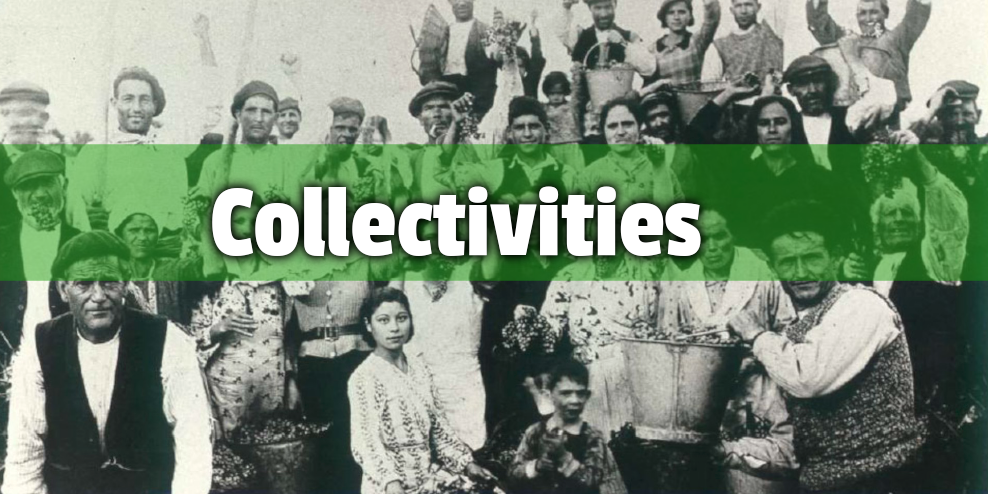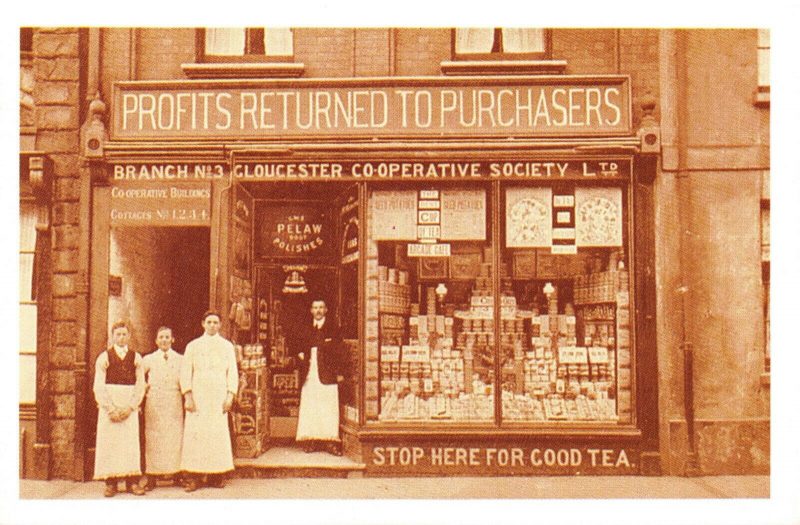Collectivities

Collectivities was the name given in Spanish, until the Spanish Revolution, to cooperatives -both of work and consumption- and communal exploitations set up by workers. During the Revolution the term was extended to the organizations that spontaneously organized the production and distribution of goods in an attempt to supply the militias but, above all, to abolish wage labor from the bottom up and to test a productive metabolism centered on the direct satisfaction of human needs.
From the first cooperatives to the Spanish Revolution

Gloucester 1910, consumers' cooperative set up by railway workers.
While consumers' cooperatives were considered collectivities, neither smallholder or stockbreeder groups nor industrial associations were considered collectivities. In that sense collectivity is much more precise and at the same time broader than cooperative. It embraces both worker and consumers' cooperatives, but leaves out business and proprietors' cooperatives.
collectivities the othe ones that set up the first workers' education and health systems in the 19th century, erected the people's houses in the early 20th century, and financed much of the big industrial strikes.
In addition, during the years of the revolution (1936-37) the organizations that spontaneously organized the production and distribution of goods were called collectivities, trying to supply the militias but, above all, to abolish wage labor from the bottom up and to test a productive metabolism centered on the direct satisfaction of human needs.
This second meaning is actually the one that gives full meaning to the term by revealing the deep intent and goals of the experiences that preceded them. In fact, during the Spanish Revolution, in most cases the old collectivities of day laborers -which in towns like Llerena integrated consumption and production- served as a skeleton for the county and village collectivities that, after July 19, abolished wages and proceeded to distribute food and basic necessities according to the needs of each family.
Viewed in perspective, the collectivities were an important framework for the organization of the working class during its rise as a political subject and the starting point from which, during the Revolution, it attempted to take over the productive apparatus in order to overcome its capitalist organization.
The collectivities during the Spanish Revolution
The collectivities within the framework of the Revolution became a moment of the seizure of the productive apparatus by the workers.
The expropriation of capitalism by workers and peasants must necessarily begin, as in Spain, by the workers taking control of the economic units as they exist. In the countryside, lacking the cellular agglutination of industry, grouping occurs spontaneously on the basis of villages and districts possessing a certain unity. It is the starting point of socialist property, but not socialist property itself. It is group property. That was the main defect of the collectivities, which was exploited by the reactionary combination of Stalinists, reformists and bourgeois, to expropriate the proletariat.
The collectivities spread throughout the country in the countryside and the city, immediately after July. Also against them, the enemies of the revolution did not launch their attack until they felt protected by sufficient armed forces. Worker and peasant property was generally recognized as a fait accompli.
G. Munis. Property (Chapter VIII of "Jalones de derrota, promesa de victoria", 1947
A warning: this is only a moment in a dynamic process. It is the totality - the political and social revolution - which gives it meaning. But group ownership - that which is a collectivity - is just that, a moment, it is not socialism per se, nor revolutionary per se, not even for attacking the commodification of labor power.
Group property cannot be more than a moment in the socialist transformation of production. It is impossible for it to be retained but for the minimum time necessary for the workers in possession of the former capitalist enterprises to articulate all production and consumption on a national scale.
The intention of the proletariat and peasants in expropriating the bourgeoisie was in no way to become owners themselves, but to create the socialist economy.
The very experience of the collectivities led them to understand that these should be the starting point of a nationwide organization of production and distribution.
The socialist economy must always have two main objectives: to satisfy the needs of the poor population and to exploit to the maximum all natural resources and technical possibilities. The latter constitutes the basis for satisfying the needs of the poor population and, developed on an international scale, must create the conditions for the complete disappearance of classes and the State.
An unrealizable task without planning the economy, failing which it is not even possible to take advantage of all the productivity that modern technology allows. The seizure and start-up of the production centers by the respective workers was an obligatory first step. To linger in it was to prove disastrous.
G. Munis. Property (chapter VIII of "Jalones de derrota, promesa de victoria", 1947
The collectivities are not only the spearhead of the laborers (proletariat), but also of the independent peasantry in subsistence regime or, at least, without wage-earners
Defeat does not detract from the example set by the peasants. Until now, the alliance of the latter with the proletariat, particularly in countries with remnants of feudal agrarian organization, was on unequal ground.
On the industrial and urban terrain, expropriation of the bourgeoisie (socialist measures); in the countryside, distribution of land to the peasants (bourgeois-democratic measures). The Spanish revolution has revealed that the alliance of the proletariat and the peasants can be considered, at least in Spain, on a socialist basis. The technical inadequacies of the country can be supplied provisionally by the revolutionary sufficiency of the peasantry.
The socialist lucidity of the Aragonese peasants went so far as to understand the need for economic coordination between their collectives and the industrial collectives of the proletariat. From the countryside came the first initiative in that sense, proposing a single system of production and administration for all the collectivities.
By its own experience, the idea was also imposed on the industrial collectives. But it was absolutely unrealizable without the full possession of political power by the proletariat and the peasants. When the idea became more or less clear, the capitalist State was already expropriating the proletariat and the weaponry, the organs of power and the revolutionary energy of the latter had been destroyed in May 1937.
G. Munis. Property (chapter VIII of "Jalones de derrota, promesa de victoria", 1947
Finally, one should not fall into the manipulation and reinterpretation - constant after 1968 - of worker collectivizations and day-labor and peasant collectivities as "self-management."
http://dictionary.marxismo.school/CollectivitiesThe collectivities of 1936-37 in Spain are not a case of self-management before the name. Some of them organized a sort of local communism with no mercantile relations other than external ones, precisely like the old societies of primitive communism.
Others were trade or village cooperatives, whose members distributed the former benefits of capital. All of them more or less abandoned the retribution of the workers according to the laws of the labor power market, as well as, some more than others, according to the necessary labor and the surplus labor from which capital extracts the surplus value and all the substance of its social organization. Moreover, the collectivities gave the combat militias gifts in kind as abundant as they were reiterated.
The collectivities can therefore be defined only by their revolutionary characteristics, in short, by the system of production and distribution in rupture with the capitalist notions of value (of exchange necessarily), the autonomy of management being a mere form in contradiction with its deep content. So much so, that this was not only the cause of its difficulties, but what allowed stalinism and the government subordinate to it, to fight and finally destroy it. The autonomy of management was therefore the negation of the collectivities. They themselves became aware of it, only too late.
G. Munis. Protest letter to the journal "Autogestion et Socialisme" (1972)